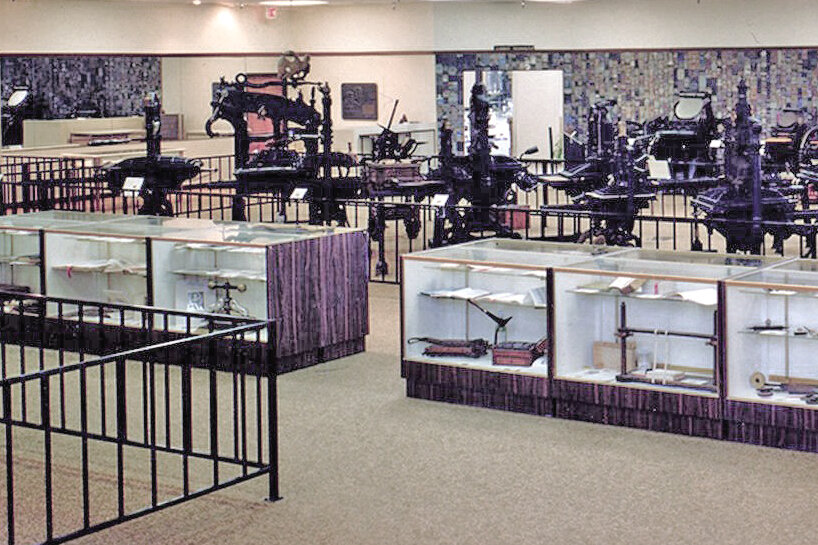KELLY PAPER OPENS NEW STORE ON MUSEUM SITE
/Museum Curator Mark Barbour Recounts Major Developments at the Museum
In the spring of 2017, Director Mark Barbour received a fortuitous phone call from an old friend. He met Josh Hellon over 20 years ago when the International Print Museum was located in Buena Park, California. We hadn’t spoken for years yet here we were having a conversation on the phone. And, being a polite museum curator, I invited Josh to drop by for a visit. Little did I know, Josh was standing outside in the Museum’s parking lot talking to me on his cell phone.
I walked outside, shook hands with Josh and asked him what brought him to our neighborhood. This is where things got interesting.
Some of you may remember what life was like for us at the Museum back in the late 1990s. Caltrans decided it needed to expand the 91 and 5 freeways and they needed the property where the Museum was located to accomplish their goals. Thus we had to vacate the premises. At the time we had no idea where were we going to relocate. This is when I met Josh.
In the late 1990s, Josh was the manager at the Kelly Paper store in Riverside, California. And, as luck would have it, we needed space to put our collection of antique printing equipment until we found a new location and Kelly Paper in Riverside had some space available.
During the next eight to nine years much of our equipment was stored at the Riverside facility. During that time Josh and I became friends. We even created a satellite museum, of sorts, at that Kelly Paper facility. Flash-forward 20-years and things had come full circle. Josh is now the Facilities Manager for Kelly Paper. This time it was Kelly Paper that was looking for a new location.
During my conversation with Josh in the parking lot of the Museum, I learned that Kelly Paper had lost its lease on their Gardena, California location. Given the proximity of the Printing Museum in Carson to their Gardena store, Josh was scouting out a location next to the Museum.
I did my best to help him with information about the building he was considering but, as I would learn two-weeks later, the location did not fit their needs. It was then that a light bulb went off in my head. Kelly Paper needed 8,000 square feet of space and we had 8,000 square feet of space in the rear building on the Museum’s property.
The problem was our 8,000 square feet of space contained our printing and teaching lab along with numerous antique printing presses and related equipment. If you’ve never seen our warehouse, imagine 2,000 square feet of printing lab and 6,000 square feet of densely packed space. There were presses and equipment on pallets stacked on racks three levels high.
Even though the building was full of equipment, I offered the location to Josh. He accepted but let me know that they had two months to get out of the Gardena location. It was then that the gravity of the situation hit me. On one hand, it would be great to have an industry partner with daily foot traffic located on our property. It would also be nice to have a regular income stream from the rent. On the other hand, what am I to do with all of that equipment, and in two months?
Adding to the situation were the school tours that I undertake every spring, three Boy Scouts Merit Badge Days, two Book Arts Patch Days, The Museum’s Independence Day Celebration, two conferences, including the national APA Wayzgoose Letterpress Conference, and prep for the Printers Fair. Thus the equipment relocation would have to take place during the busiest time of the year. During the following weeks and months, we packed presses and equipment into large 40-foot long steel shipping containers for storage. It just so happened that the Kelly Paper store in El Monte, California had enough space for 10 of the shipping containers along with 1,500 square feet of indoor warehouse space. Thus we were able to remove the equipment and Kelly Paper could move to their new location.
During this time we were able to develop an exhibit in planning for many years. In the Museum’s main building we sectioned off an area in the East gallery and turned it into a 1950’s printing shop, complete a Linotype, Heidelberg Windmill & Cylinder presses, platen presses, and neon signs from local shops. We patterned it after the old Wood & Jones Printing Company that was located on West Colorado Boulevard in Old Pasadena. Our goal was to create an experience in which a person could get the sense of walking into a working mid-century printing company.
So, from April to October of 2017, we consolidated, winnowed, stored, and sold what equipment we could, all the while hosting seven major events at the Museum. The capstone of the events was our Los Angeles Printers Fair in October with over 1,700 attendees. I must say 2017 will go down in the Museum’s history as one of the most challenging, yet satisfying years ever.




